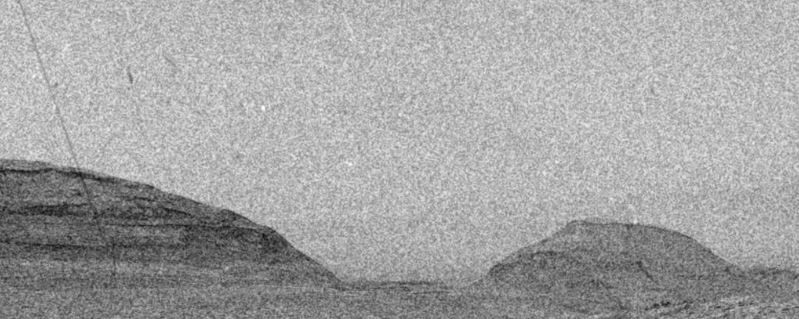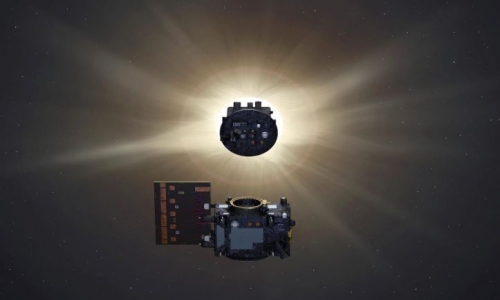


 2:37:5
2:37:5  2024-06-14
2024-06-14  898
898

In recent weeks, the Sun has become so rowdy that Earth has been repeatedly bombarded with the radiation and particles emitted by eruptions of solar plasma.
But Earth is not the only planet affected by solar storms. At just 1.5 times Earth's distance from the Sun, Mars has also been buffeted by the huge ejections of particles blasted out through the Solar System.
The red planet's magnetic environment and atmosphere are much weaker than those of Earth, so the effects of solar storms look a little bit different there. But instruments such as those on the MAVEN orbiter have registered those effects – and now we can parlay that data into understanding the radiation environment on Mars, and how it may impact future human explorers.
"This was the largest solar energetic particle event that MAVEN has ever seen," says physicist Christina Lee of the University of California, Berkeley. "There have been several solar events in past weeks, so we were seeing wave after wave of particles hitting Mars."
Here on Earth, the biggest effects were seen in early May, when eruptions known as coronal mass ejections (CMEs) – huge ejections of solar plasma and magnetic fields that sometimes occur in concert with solar flares – were spewed in our direction.
The result was a spectacular array of auroral colors seen at latitudes not normally privy to such sights, as solar particles tangled with Earth's magnetic field and rained down onto Earth's atmosphere where interactions with its particles produced a stunning lightshow.
The sunspot region responsible for those eruptions subsequently rotated away to the far side of the Sun, but our host star was not done with its shenanigans. On 20 May, an absolutely enormous eruption occurred on the Sun's far side, a flare estimated to be at X12, which would place it among the most powerful solar flares ever detected. Immediately after, a CME spewed forth – and Mars was in the firing line.
Light from the flare arrived first, bathing Mars in solar X- and gamma radiation. The CME particles travel substantially slower than the speed of light, so they arrived a little later, triggering auroras in the Martian atmosphere.
Now, Mars doesn't have a global magnetic field the way Earth does. It doesn't have the operational internal activity – a dynamo – to produce it. On Earth, the magnetic field accelerates solar particles to the poles, where they rain down into the ionosphere. That's why aurora activity is centered at higher latitudes.
Because Mars doesn't have a magnetic field than can do this, auroras there tend to be global. But there's a catch. The resulting 'light shows' are in ultraviolet – meaning we wouldn't be able to see them with the naked eye.
Luckily, we have satellites orbiting the red planet that can. MAVEN has been capturing ongoing ultraviolet fluctuations in the Martian atmosphere as wave after wave of solar particles slam into it.
Rovers on the surface measured the influx of radiation from the flare, too. Earth's atmosphere blocks the most energetic light from reaching the surface, but the volume of the atmosphere surrounding Mars is less than 1 percent of the volume of Earth's, leaving almost no protection from the Sun's rays.
Following the giant flare, Curiosity's Radiation Assessment Detector logged a radiation surge up to 8,100 micrograys – the equivalent of 30 chest X-rays at once and the biggest surge recorded by the rover. Such a surge wouldn't be deadly, but it wouldn't exactly be great for one's health, either.
In fact, Curiosity's black and white images obtained during the storm are filled with 'snow' – static produced by charged particles interacting with the camera.
The measurement gives scientists working on developing the Mars mission a key datapoint for understanding what sort of radiation environment explorers might be entering, which can help design strategies for avoiding or being protected from surges.
"Cliffsides or lava tubes would provide additional shielding for an astronaut from such an event. In Mars orbit or deep space, the dose rate would be significantly more," says physicist Don Hassler of the Southwest Research Institute.
Meanwhile, as we enter the most active phase of the solar cycle, even more tempests are predicted. Hassler adds, "I wouldn't be surprised if this active region on the Sun continues to erupt, meaning even more solar storms at both Earth and Mars over the coming weeks."
Reality Of Islam |
|

Monash scie

Two spacecr
 9:3:43
9:3:43
 2018-11-05
2018-11-05
10 benefits of Marriage in Islam
 7:5:22
7:5:22
 2019-04-08
2019-04-08
benefits of reciting surat yunus, hud &
 9:45:7
9:45:7
 2018-12-24
2018-12-24
advantages & disadvantages of divorce
 11:35:12
11:35:12
 2018-06-10
2018-06-10
 6:0:51
6:0:51
 2018-10-16
2018-10-16
 4:26:43
4:26:43
 2022-02-21
2022-02-21
 6:14:3
6:14:3
 2023-01-18
2023-01-18
 12:47:1
12:47:1
 2022-12-20
2022-12-20
 7:34:7
7:34:7
 2023-02-28
2023-02-28
 7:32:24
7:32:24
 2022-02-14
2022-02-14
 7:59:14
7:59:14
 2018-06-21
2018-06-21
 5:57:34
5:57:34
 2023-03-18
2023-03-18
 5:41:46
5:41:46
 2023-03-18
2023-03-18
| LATEST |